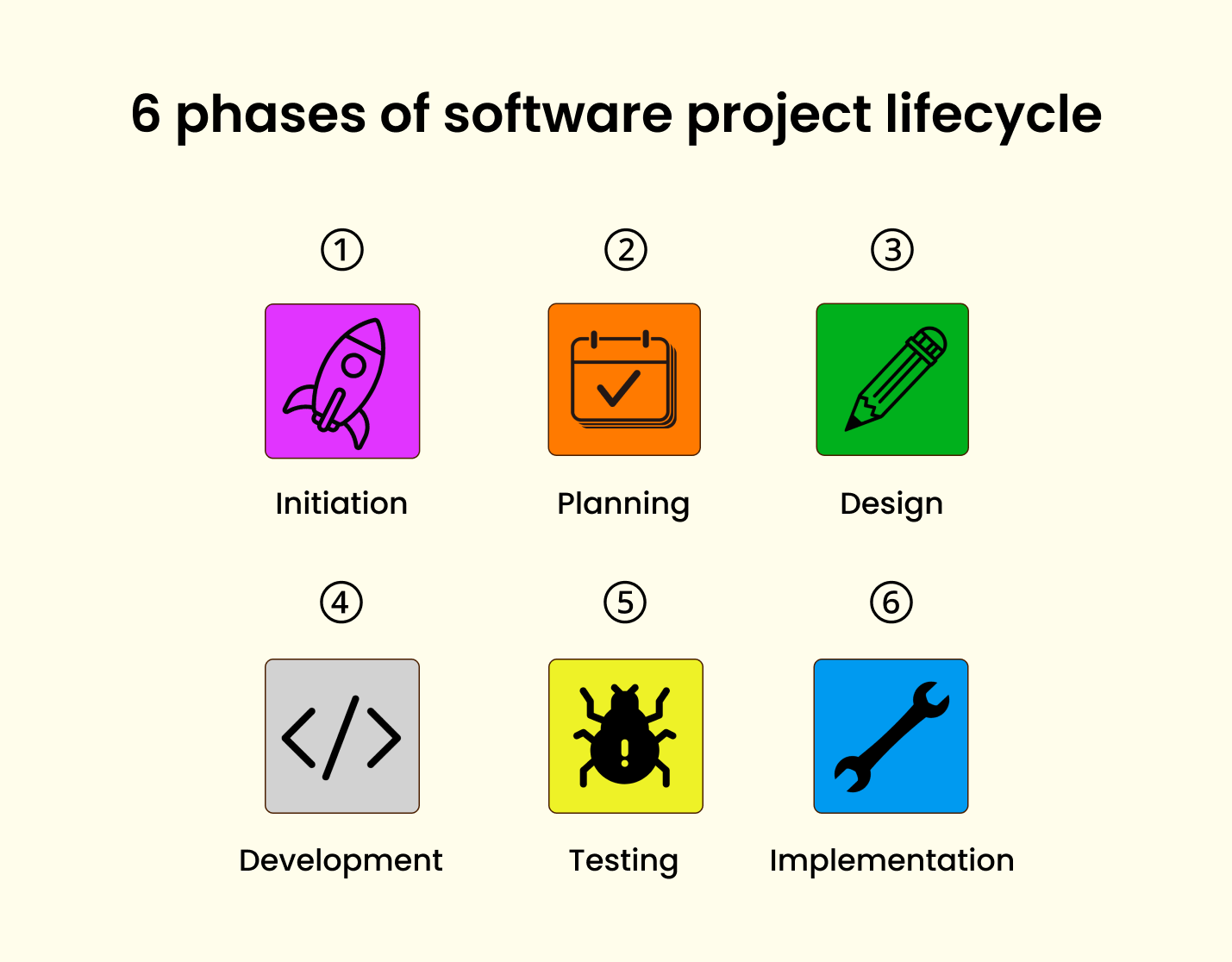What Is Software Project Management?
Software project management encompasses the planning, organization, and oversight of software development to guarantee that projects are completed on time, within budget, and to a high standard. It tackles specific challenges such as evolving requirements and technical difficulties. Successful management involves establishing clear objectives, managing resources effectively, and utilizing methodologies like Agile or Waterfall. This systematic approach merges technical knowledge with leadership skills to steer projects from their initial concept through to deployment, enabling teams to remain organized, adhere to deadlines, and respond to changes effectively, ultimately transforming ideas into successful digital products.
Software project management (SPM) pertains to the strategies and processes employed to supervise software development. It spans the entire process from the initial planning stages to the final delivery of the product. The scope includes setting project objectives, distributing resources, monitoring progress, and mitigating risks.
In software project management, the emphasis extends beyond just coding; it also involves coordination among team members. Teams must manage tasks such as gathering requirements, designing, testing, and deploying the software. The project manager plays a crucial role in ensuring that developers, testers, and stakeholders collaborate seamlessly.
The scope of management can differ based on the project’s scale. Smaller projects may require basic tracking, while larger software initiatives necessitate comprehensive planning and coordination among multiple teams. Regardless of the project’s size, the fundamental principles of delivering a functional product efficiently remain constant.
The Importance of Software Project Management in the Software Lifecycle
Effective software project management is essential for keeping development on track. Without it, projects can experience delays, budget overruns, or even failure. A well-managed project follows a clear path, minimizing confusion and wasted effort.
In the software lifecycle, project management ensures that each phase—requirements, design, coding, testing, and deployment—proceeds smoothly. It enables teams to identify potential issues early and adjust plans accordingly. For instance, if a feature takes longer to develop, the project manager can reallocate resources to maintain the schedule.
Strong project management also enhances communication among developers, testers, and clients, reducing misunderstandings. This alignment ensures that the final product meets both business needs and user expectations.
Key Responsibilities of a Software Project Manager
A software project manager plays a vital role in guiding a project from inception to completion. They oversee planning, team coordination, and problem-solving to ensure successful delivery. This role requires a blend of technical knowledge and leadership skills to keep development on track, acting as a bridge between developers, stakeholders, and business objectives.
Effective software project management involves juggling multiple tasks. The manager must set clear objectives, organize teams, monitor progress, and manage risks. Without proper oversight, projects can encounter delays, budget issues, or quality concerns.
Planning and Scope Management
The first major responsibility is planning. The project manager outlines what needs to be accomplished and how. This includes establishing timelines, budgets, and deliverables while collaborating with stakeholders to clarify requirements.
Scope management is equally crucial. The manager ensures the project remains focused on its goals, preventing unnecessary changes that could lead to delays or increased costs. When new requests arise, they assess the impact before granting approval. A well-defined scope keeps the team aligned and avoids wasted effort.
Team Coordination and Communication
Software development involves various roles—developers, testers, designers, and more. The project manager ensures everyone collaborates effectively. They assign tasks based on skills and availability, ensuring no one is overwhelmed or underutilized.
Communication is key in software project management. The manager organizes meetings, shares updates, and resolves conflicts. They ensure developers understand requirements and stakeholders receive regular progress reports. Effective communication prevents misunderstandings that could hinder the project.
Execution and Monitoring

Once work begins, the project manager tracks progress, checking if tasks are completed on time and within budget. If delays occur, they adjust schedules or resources to stay on track.
Monitoring also involves quality control, ensuring testing occurs at appropriate stages, verifying that the software meets requirements before release. Regular check-ins help identify problems early, reducing the need for last-minute fixes.
Stakeholder and Risk Management
Stakeholders include clients, executives, and end-users. The project manager keeps them informed and gathers feedback, balancing business needs with technical constraints to deliver a product that satisfies all parties.
Risk management is another critical responsibility. The manager identifies potential issues—such as technical challenges or team shortages—before they escalate. They develop contingency plans to address unexpected setbacks, minimizing disruptions and keeping the project on course.
The Six Phases of the Software Project Lifecycle

Every software project follows a structured path from concept to final product, known as the software project lifecycle. This framework breaks the work into clear phases, helping teams stay organized and deliver quality results. Each phase has specific goals and deliverables, and effective project management ensures smooth transitions between stages.
The six main phases provide structure to software project management, guiding teams from initial planning to coding, testing, and final release. Adhering to this approach reduces risks and enhances efficiency, as each phase builds on the previous one.
Initiation
The first phase defines the project’s objectives. Teams identify key goals and stakeholders, documenting business needs and technical requirements. The project manager evaluates the idea’s feasibility and its potential value.
Initiation lays the groundwork for software management. Teams outline the project scope, budget, and timeline while identifying potential risks and challenges. Clear objectives at this stage help prevent confusion later in the project.
Planning
Once approved, detailed planning begins. The project manager creates schedules, assigns tasks, and allocates resources to determine how the team will approach development. Technical specifications and design requirements are also finalized during this phase.
Thorough planning is crucial in software project management. It ensures that everyl team member understands their roles and establishes contingency plans for potential issues. A well-structured plan keeps the project progressing smoothly toward completion.
Designing
In this phase, architects and designers create the software blueprint, defining how the system will function and appear. They plan user interfaces, databases, and system integrations, producing technical documents to guide developers during coding.
Design plays a critical role in the software project management process. A strong design simplifies development and reduces errors. Designs are reviewed with stakeholders to confirm that all requirements are met before coding begins.
Development
During this phase, programmers write the actual code based on the designs. This is typically the longest phase in software projects. Developers work in sprints or stages to build various features, with regular code reviews to ensure quality standards are met.
Throughout development, software project management focuses on tracking progress. Managers monitor whether work stays on schedule and within budget, coordinating among team members to quickly resolve technical challenges.
Testing
Before release, the software undergoes thorough testing. Quality assurance teams check for bugs and performance issues, ensuring all features function as intended. Testing occurs in cycles, with fixes implemented between each round.
In software management, testing is crucial for preventing costly problems post-launch. Various test types assess security, usability, and compatibility. The software only moves to final deployment once all tests pass.
Implementation
The final phase involves delivering the finished product to users. Teams install the software on servers or release it to app stores, which may include data migration and user training.
Successful implementation signifies the completion of the software project lifecycle. Post-launch, software project management continues with maintenance. Teams monitor performance and address any emerging issues while planning future updates based on user feedback.
Popular Software Project Management Methodologies
Selecting the right approach is vital for successful software development. Different project management methodologies help teams organize work according to project needs. These frameworks guide how teams plan, execute, and deliver projects, influencing communication, flexibility, and overall efficiency.
Software project management relies on established systems to navigate complex development cycles. Some methods follow strict, step-by-step processes, while others offer more flexibility. Teams choose methodologies based on project size, team structure, and client requirements. The right choice can significantly impact project success.
Agile (Scrum & Kanban)
Agile has emerged as the most popular approach in modern software management, emphasizing flexibility, collaboration, and incremental delivery. Scrum and Kanban are two widely adopted Agile frameworks.
Scrum divides projects into short sprints, typically lasting two to four weeks. Teams hold daily stand-up meetings to track progress, reviewing completed work and planning next steps after each sprint. This approach is particularly effective for projects with evolving requirements.
Kanban employs visual boards to track tasks as they progress through various stages, limiting work in progress to enhance focus and efficiency. Kanban is ideal for teams managing ongoing maintenance or frequent small updates. Both methods prioritize continuous improvement and customer feedback in software project management.
Waterfall
The Waterfall methodology follows a strict linear sequence, requiring each phase to be completed before the next begins. Requirements are defined upfront, followed by design, development, testing, and deployment.
This traditional approach is best suited for projects with clear, stable requirements. Industries with strict regulations often utilize Waterfall in software project management. While less flexible than Agile, it provides clear milestones and documentation. The main risk arises when changes are needed after development begins, as reverting to earlier phases can be challenging and costly.
Hybrid Approaches
Many teams blend elements from different methodologies, creating hybrid approaches that combine the structure of Waterfall with the flexibility of Agile. This is effective for large projects that require both careful planning and adaptability.
In software management, hybrid methods might use Waterfall for overall planning while employing Agile for development sprints. Some teams adopt Scrumban, merging Scrum’s structure with Kanban’s visual workflow. Software project management often benefits from these customized solutions, allowing teams to adjust processes based on actual project needs rather than adhering strictly to methodology rules.
Common Challenges in Software Project Management
Managing software projects presents distinct challenges that can disrupt even the best-laid plans. These obstacles test the effectiveness of management strategies and demand proactive solutions. Teams often feel pressured to deliver high-quality products quickly while navigating shifting requirements and technical limitations.
To keep projects on track and meet deadlines, software project management must address these challenges. From changing project goals to resource shortages, each issue affects the development process in unique ways. Identifying these problems early allows teams to implement preventive measures and maintain control over their projects.
Scope Creep
Scope creep occurs when new features or requirements are added during development without proper assessment. What begins as a straightforward project can expand significantly. This gradual increase often happens when stakeholders request changes without fully understanding their impact on timelines or budgets.
In software management, scope creep can lead to delayed deliveries and budget overruns. Teams may work longer hours to accommodate unexpected changes, which can compromise quality. To prevent this, it’s essential to document initial requirements clearly and establish a strict change control process. Project managers should evaluate every new request before granting approval.
Resource Bottlenecks
Resource bottlenecks arise when teams lack the necessary personnel, tools, or time to complete tasks efficiently. A shortage of skilled developers, slow approval processes, or limited testing environments can hinder progress. These constraints can create delays that affect the entire project timeline.
Effective software project management anticipates these bottlenecks before they escalate. Proper resource allocation and contingency planning enable teams to adapt when shortages arise. Cross-training team members and maintaining backup vendors can also reduce reliance on limited resources.
Technical Debt
Technical debt builds up when teams take shortcuts to meet deadlines, sacrificing code quality for speed. While these quick fixes may provide temporary relief, they can lead to long-term issues. Poorly written code becomes harder to maintain, slowing down future updates and increasing the risk of bugs.
Managing technical debt requires a balance between speed and quality. Regular code reviews, thorough documentation, and dedicated time for refactoring can help minimize this issue. Addressing small problems early prevents them from escalating into major obstacles later in the project.
Tips and Best Practices for Software Project Managers
Successful software project management involves more than just technical expertise. It requires strong leadership, clear processes, and a commitment to continuous improvement. Experienced managers employ proven strategies to keep teams productive and projects on track. These best practices help navigate the complexities of software development while ensuring quality and efficiency.
In software management, even small improvements in approach can yield significant results. Whether managing timelines, teams, or technical challenges, the right techniques can make a difference. Project management becomes more effective when managers prioritize communication, measurable progress, and learning from each project. These strategies help teams consistently deliver better results.
Communication-First Leadership
Clear communication is the cornerstone of successful projects. Managers must ensure that all team members and stakeholders understand goals, progress, and challenges. Regular updates help prevent misunderstandings that could delay work or compromise quality.
A communication-first approach in software management emphasizes listening as much as directing. Teams perform better when they feel heard and informed. Daily stand-ups, progress reports, and open feedback channels keep everyone aligned. This leadership style fosters trust and helps identify potential issues early in the project.
Using the Right Metrics
Tracking meaningful metrics provides objective insights into project health. Instead of relying on assumptions, managers should monitor data such as sprint velocity, defect rates, and milestone completion. These metrics reveal what is working and what needs adjustment.
Effective software project management uses metrics to make informed decisions without micromanaging. The key is to select indicators that accurately reflect progress toward goals. Too many metrics can create confusion, while too few can provide an incomplete picture. Striking a balance is essential to maintain focus on what matters most.
Post-Project Retrospectives
Every completed project offers valuable lessons. Retrospectives bring teams together to discuss successes and areas for improvement. These candid conversations help refine processes for future work.
In software project management, retrospectives should focus on solutions rather than assigning blame. Teams should identify specific actions to repeat or change in future projects. Documenting these insights ensures continuous improvement across initiatives. This practice transforms experience into better project management with each new endeavor.
By prioritizing these areas, managers create environments where teams can excel. Strong communication, data-driven decisions, and a commitment to learning from experience form the foundation of effective software management. These practices enable teams to deliver quality results while enhancing their capabilities over time.




